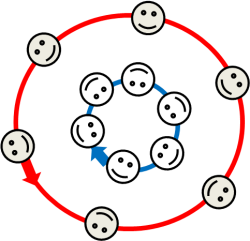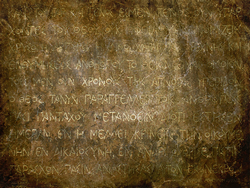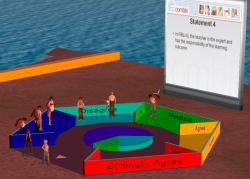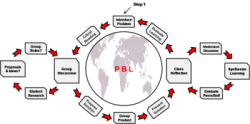Karusselldiskussion
Karusselldiskussion

Illustration von Denis Edlich (abgerufen am 26.12.2009)
Kurzbeschreibung
Bei der Karussell-Diskussion können viele unterschiedliche Themen simultan in vielen Zweiergruppen andiskutiert werden. Oder es kann eine gruppeninterne Überprüfung von Lerninhalten erfolgen, bei der offene Fragen/Probleme/Diskussionsbedarf deutlich werden.
Ablauf
Das Moderatorenteam hat zwei Stuhlkreise aufgebaut, einen Innenkreis und einen Außenkreis, wobei sich jeweils ein Stuhlpaar - einander zugewandt - gegenübersteht.
Die Gruppe wird halbiert und die Teilnehmer verteilen sich gleichmäßig auf die Stuhlkreise.
Zunächst erhalten die Teilnehmer im Innenkreis einen vorbereiteten Themenzettel. Darauf können Satzanfänge, Argumente zum Thema und allgemeine Fragen stehen. Sie wählen sich ein Thema aus, diskutieren es mit ihrem Gegenüber eine bestimmte Zeit lang (maximal drei bis fünf Minuten) und notieren die wesentlichen Antworten.
Die Teilnehmer im Außenkreis rücken anschließend einen Platz zur Seite und sie erhalten nicht nur ein neues Gegenüber, sondern gleichzeitig bekommen sie von ihm den Themenzettel.
Nun beginnt das Spiel von Neuem: Die Teilnehmer aus dem Außenkreis schlagen nun ihrerseits dem Innenkreis ein Gesprächsthema vor. Dieses Verfahren kann beliebig oft durchgeführt werden.
Bei der Auswertung im Plenum können folgende Fragen hilfreich sein:
Welche Themen habe ich gewählt?
Welche Themen habe ich vermieden?
Wer hat mich am meisten überrascht?
Welches Thema ist mehrfach angesprochen worden?
Benötigte Tools und Materialien
Vorbereitete Themenzettel
Beispiele und Links
Meine Erfahrungen in der Fortbildung konnte ich im Kollegium weitergeben, weil …
Die Lernenden waren sehr angetan von der Projektmethode. Am meisten gefiel ihnen …
Meine Lernenden hatten Wünsche und Vorschläge, die über die Inhalte dieses Projektes hinausgingen. Da habe ich …
Die Arbeitsbedingungen an meiner Schule waren sehr schwierig. Da wäre einiges zu ändern, z. B. …
Die Lernenden waren sehr interessiert, aber …
Meine Teilnahme an der Fortbildung hat meine Stellung im Kollegium verändert. Folgendes habe ich wahrgenommen: …
Die Lernenden waren oft wenig arbeitswillig und meine Unterrichtsvorbereitung …
Über einige Inhalte wussten einzelne Lernende besser Bescheid als ich. Das fand ich …
Am Ende des Projektes schenkten mir meine Eltern ... Darüber habe ich ...
Meine Lernenden bekamen keine Hausaufgaben. Trotzdem …
Ich möchte in Zukunft gerne an weiteren Fortbildungen teilnehmen, weil …
Eine gute Leistung ist für mich …
Eine schlechte Leistung ist für mich …
Eine tolle Leistung ist für mich …
Ich habe versagt, wenn …
Ich habe etwas geleistet, wenn …
Leistung erbringen ist für mich …
Gute Leistungen sind wichtig für …
Ein schwacher Lernender hat eine tolle Leistung erbracht, wenn …
Über Leistung nachzudenken ist für mich …
Von der heutigen Fortbildung erwarte ich besonders …
Am Ende der Sitzung sollte …
Wichtig ist für mich bei diesem Thema …
Kommentare
Da die Gespräche im Laufe der Zeit intensiver werden, können die Zeiteinheiten vergrößert werden (Anfangs drei, dann fünf, dann sieben Minuten).









![Bild zur Methode Elgg [de]](../tools/elgg/elgg.png)


